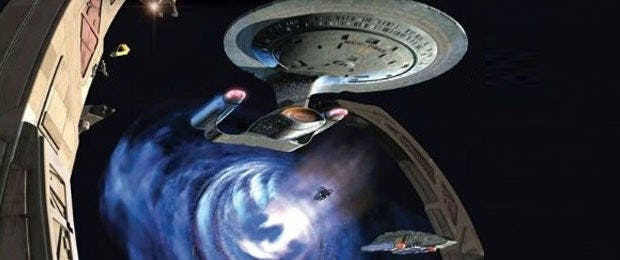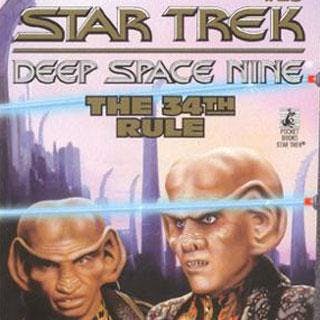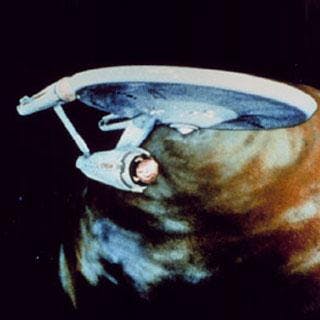Published May 28, 2012
David R. George III On Trek Novels, His Career, Part 2
David R. George III On Trek Novels, His Career, Part 2

Today, in the second half of our StarTrek.com interview with David R. George III, the prolific Star Trek author talks in more detail about his current projects, the Typhon Pact novels Plagues of Night and Raise the Dawn, which will be released on May 29 and June 26, respectively, by Simon and Schuster. George also discusses his other Trek work -- such as writing a DS9 novel with Armin Shimerman and co-writing the story for the Voyager episode "Prime Factors" -- and assorted upcoming endeavors.
Which characters within the Typhon Pact stories do you find come most easily to you?
George: To be honest, I actually don’t find any real difficulties writing any of the characters. Having watched the series and films, and having read through the literary travails of our heroes, I know them pretty well. That said, there are some characters to whom I gravitate more than others. Among the regular troupes of Star Trek personnel, I have a particular fondness for Benjamin Sisko and Kira Nerys, whose long- and short-term arcs have been so enjoyable for me to follow as a viewer and reader. I also really like to write Elias Vaughn and Prynn Tenmei, a pair of books-only characters. In my latest Typhon Pact novels, I had a wonderful time with the president of the Federation, Nanietta Bacco, as well as with the new praetor of the Romulan Star Empire, Gell Kamemor, who I actually introduced years earlier in my Lost Era novel, Serpents Among the Ruins.
I am always mindful, though, that all the characters must serve the story. I try not to force anything; I want to let Sisko and Kira and all the others act consistently with what we’ve seen before from them. You can pen a tale where Kira forsakes her long and deeply held religious beliefs, but you’d better have an extremely compelling—and therefore believable—reason for her to do so. I know these characters, but so do the readers.

You've got a doubleheader coming up with Plagues of Night and Raise the Dawn. Give us a preview of both stories, how interlocking they are in terms of the plots and the emotional cores beneath the loglines?
George: Plagues of Night picks up the arc of the Typhon Pact after all the events of the first four TP novels. In particular, it focuses on the continuing antipathy and distrust that some within the Pact feel for the Federation, and their concern that the UFP’s quantum slipstream drive is a genuine threat. Other factions within the Typhon Pact, though, see opportunity in peace with the Federation. This sets up an internal tension inside the Pact, which provides even more dramatic conflict.
Plagues of Night and Raise the Dawn are strongly linked, with the former leading directly into the latter. The novels include elements from the original Star Trek, The Next Generation and Deep Space Nine. In particular, though, Ben Sisko, Ro Laren, and Kira Nerys play significant roles, along with Captain Picard, President Bacco and Praetor Kamemor.
How busy a boy were you cranking them out back to back, and in what ways was that helpful/challenging?
George: To say I was busy is something of an understatement. With Plagues of Night leading directly into Raise the Dawn, I thought that I’d end up treating the overall project as something singular. The reality of working on the two books, though, was something quite different. A novel -- even one that takes up the story where the previous novel left off -- can’t really be treated as the second half of a tale. Every novel requires its own structure, with its own beginning, middle, and end, its own themes, its own conflicts and resolutions. I loved writing the two books back-to-back, but it surprised me how much work I had to do simply to begin the second one. I’d expected it to flow quickly and naturally from the first, but it turned out to be considerably more difficult.

Between the two books, that's 275,000 words across 800 pages. How did you keep track of it all? Are you a file card on the wall kind of guy? And, in editing/proofing it, how do you step outside yourself to see what's actually on the page versus what you think is there?
George: Keeping track of story threads and characters really comes with the territory of writing a novel -- or in this case, two novels. I’m not a file-card-on-the-wall type of writer, though I will use whatever tools I need to accomplish my goals -- and I did use index cards for one of my novels, Twilight, which intermingled multiple storylines across multiple settings, all across a 200,000-word length. But for Plagues of Night and Raise the Dawn, I was able simply to refer to the detailed narrative outlines I’d penned for them.
What can be problematic is the sheer volume of words. It can be very easy to repeat yourself, or to leave some important detail out. To avoid such issues, I relied on the editing process, where I reread what I’d written with a critical eye. Having done this a number of times -- Plagues and Dawn are my tenth and eleventh novels -- I’ve learned how to divorce writing from editing, to let go of what I’ve written so that I can look at it more objectively. Also, thankfully, I have an editor who knows their job, and who functions as a vital asset for me.
Rank the following in order, in terms of what gives you the most satisfaction: coming up with an idea, getting a contract from a publisher, writing a story, writing "the end" as you finish, publisher/editor signing off on the final edit, receiving that box of books at your home? And, why that order?
George: By far, the most satisfying part of writing for me is the actual writing itself. The search for what to say and how to say it, the careful development of thematic elements, the crafting of chapters, paragraphs, even single sentences, are what it’s all about. The process can be slow, difficult, even infuriating, but it’s also extremely fulfilling. And sometimes, it feels magical.
After that, I guess I’d have to say that finishing comes in second, followed by coming up with an idea. The other things -- getting a contract, receiving final approval on a manuscript, even opening that first box of my own work -- are all far behind. It’s obviously important for me to get paid to do what I do, and so I necessarily need to receive contracts and approvals, but those are just adjuncts to the artistic process. And by the time I finally receive a freshly printed copy of my latest work, I’m already emotionally past that story and on to the next. Don’t get me wrong: I thoroughly enjoy all of those things, but in terms of satisfaction, it all pales after actually getting to sit down and write.
Though you had to work hard to write Plagues and Raise back to back, the reader will get to soak up both stories within a month of each other. What do you think that adds to the experience, especially since, in essence, Plagues and Raise are a duology?
George: While Plagues of Night leads directly into Raise the Dawn, and while story threads begun in the first are picked up in the second, the two books really do tell distinct stories. There are common elements, of course, and as has long been true of Deep Space Nine, some new plots are introduced but not resolved, and some old plots are completed. For all of that, though, I think readers will benefit from the publication of the two novels in successive months, as they will in short order get two books with their own stories to tell, but that together relate an overarching story. And if I’ve done my job well, they’ll move breathlessly from one to the other.

Some fans may not realize you wrote The 34th Rule with Armin Shimerman. What do you remember of collaborating with Armin?
George: I loved collaborating with Armin on The 34th Rule, not least of all because I gained a new friend from the experience. Although I ended up writing the actual novel myself-- something Armin freely tells people -- he and I worked very hard on developing the detailed outline for it. In addition to being a gifted actor, Armin possesses a theatrical flair for storytelling. He also has a great love of language, and a deep-rooted appreciation for theme. I remember our many outlining sessions as involved, high-energy, artistically satisfying times.
Some fans also may not realize you co-wrote the story for the Voyager episode "Prime Factors." How did that come to pass? Were you given a shot at writing the script? Which ideas that you and Eric Stillwell developed could you recognize in the script, and what did you make of the finished episode?

As far as the completed project, I was more or less pleased by it. I liked the basic idea of Starfleet officers having the Prime Directive turned around on them. I also thought it important to explore the idea of just what the captain and her crew would be willing to do in order to get home. And finally, I loved setting up the conflict between Captain Janeway and Lieutenant Commander Tuvok.
We understand you've got at least one more Trek novel in the works, possibly more. So, what are you working on now, Trek-wise? Does what was tentatively entitled The Red Ensign now have a more official title you can reveal? Also, will the new book pick up where Raise the Dawn leaves off, or is it something else entirely?

Since then, I have written an outline for the novel, which has already received editorial approval. Now that I have my story and themes laid out, I am calling the book Allegiance in Exile. I caution readers that this should be considered a working title and could yet change as I make my way deeper into the novel.
Since the book is set in the Twenty-Third Century, it’s a safe bet that it will not pick up where Raise the Dawn leaves off. It is my belief, though, that other works will continue the Deep Space Nine story, especially since 2013 marks the twentieth anniversary of the show’s premiere. It’s also entirely possible that I’ll be the one to do that.
How about non-Trek writing? What else do you have on the way?
George: At the moment, I am writing an original novel as well as working on Allegiance in Exile. Since I have a deadline on the Star Trek novel, it takes precedence, but I do hope to finish the other work sometime this year. If and when my original novel does get published, I hope that Trek fans will follow me there and give it a read.
Click HERE to read part one of our interview with David R. George III. Click HERE to check out his Facebook page and click HERE to pre-order Star Trek: Typhon Pact -- Plagues of Night.

